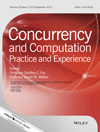A QoS-aware service discovery method for elastic cloud computing in an unstructured peer-to-peer network
SUMMARY
Traditionally, service discovery is often promoted by the centralized approach that typically suffers from single point of failure, poor reliability, poor scalability, to name a few. In view of this challenge, a QoS-aware service discovery method is investigated for elastic cloud computing in an unstructured peer-to-peer network in this paper. Concretely speaking, the method is deployed by two phases, that is, service registering phase and service discovery phase. More specifically, for a peer node engaged in the unstructured peer-to-peer network, it firstly registers its functional and nonfunctional information to its neighbors in a flooding way. With the multiple registered information, the QoS-aware service discovery is promoted in a probabilistic flooding way according to the network traffic. At last, extensive simulations are conducted to evaluate the feasibility of our method. Copyright © 2013 John Wiley & Sons, Ltd.




